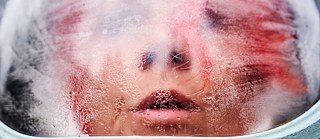“48 Hours in Novosibirsk”
Siberian Garage Blues

Arousing interest in art, strengthening the local scene: The Goethe-Institut brought the idea of the Berlin art festival 48h Neukölln to Novosibirsk.
By Beate Scheder
How can the present-day be recounted? In 1928, the journalist Alexander Lvovich Kurs asked himself that question and founded a journal with the programmatic name The Present. It was radical in many ways – visually and in its content, with open debates and a biting satirical style – and only existed until 1930.
The Present is a bit of Novosibirsk’s avant-garde that gathered dust in the library until Pyotr Zherebtsov became aware of it. Zherebtsov, around 30 years old, is one of the hopefuls for Novosibirsk and for contemporary art. For a year and a half he’s been curator at ZK19, Novosibirsk’s new centre for contemporary art and culture, which presented itself to the public for the first time at the 48h Novosibirsk festival, a public that previously had little exposure to art, contemporary art at least, as there were hardly any places for them to see it.
The festival was held in mid-September for one weekend, as suggested by the name, which may sound familiar to Berliners. For 48h Novosibirsk, the idea and concept of the now 20-year-old district art festival 48h Neukölln was exported to Siberia as a joint project of the Goethe-Institut Novosibirsk, the Kulturnetzwerk Neukölln e. V. and ZK19.

The art scene is as bumpy as the streets
Martin Steffens and Thorsten Schlenger founded 48h Neukölln back then to counter the negative headlines about the hot spot neighbourhood in Berlin. It is a festival by the scene for the scene, decentralised, participative, for anyone who likes to drift along the neighbourhood streets. They’ve changed rapidly since then, Neukölln has become a blueprint for gentrification, but art has preserved some of its charming roughness.
The present in Novosibirsk in autumn 2019 glows in the orange of the sea buckthorn sold by babushkas on the street and in the red of the rowan berries ripening on the trees in front of prefabricated buildings and tsarist-era wooden houses, constructivist buildings and heroic monuments. The art scene here is as heterogeneous as the architecture, as bumpy as the streets.
Zherebtsov describes it as more fragmented than in other major cities. ZK19 wants to reform the structures, curate art, not just present it; a laborious process, but now seems to be the right time.
Prisoners’ tattoos in embroidery
Per Brandt, director of the Novosibirsk Goethe-Institut, also wants to strengthen the local art scene – not just with the festival but with a continuous programme. There’s still a long way to go, even between the festival locations. They spread across the entire city centre. Some of them, like ZK19, opened their doors for the first time on the art weekend. In the main exhibition, curated by Zherebtsov and Steffens, Neuköllner and Novosibirsk positions met.
Claudia von Funcke’s video installations, the abstracted images and sounds from Berlin and Novosibirsk fitted together, met Mayana Nasybullova’s plaster casts of manhole covers. Nasybullova, born in 1989, a poster girl of the city’s young art scene, also had a solo exhibition in the Post Gallery, a new art venue where state security was once housed, for which she embroidered tattoos of Russian prison inmates.
Bold, controversial works that were easier to show as part of the festival and were somewhat protected by the participation of the Goethe-Institut.

Supremacism from sausage slices
Olga Posukh can’t make a living from her art but she doesn’t need to either. Together with her collective Zoskaprint, she put together an exhibition for 48h Novosibirsk entitled Dirty Women. Each work was or would be censored in other galleries for showing nudity or addressing taboo subjects such as menstruation, prostitution or sexual abuse. Harmless to the Western eye, they are too much for some of the locals.
The only two artists from Novosibirsk that might be known in this country are experts in provocation. The Blue Noses have been putting Siberia on the art world’s radar for the past twenty years, including two appearances at the Venice Biennale.
For the festival, they set up a small museum of their art. There’s Slava Mizin, one half of the remaining actionists, filling vodka in plastic cups, on the walls around him are the collected works of the Blue Noses: the artists disguised as peasants, with false beards and axes, bodybuilders posing next to a portrait of Lenin, supremacism from sausage slices. “Stay here, don’t go to the garage, it’s hard to find anyway,” he advises.
The parallel universe of the garage
Garages are a Novosibirsk, a Russian specialty. In the 1990s when it was dangerous to leave one’s car parked on the street they were built in huge numbers, Alexey Grishchenko explains, leaning beside his father’s. There aren’t many cars here; garages developed into parallel universes where some hang out with friends or operate semi-legal businesses or where someone like Grishchenko has been organising monthly exhibitions for three years that anyone can take part in. In Grishchenko’s garage the art feels light, playful. If something falls down, someone simply hangs up back up.
For many young people of Novosibirsk, the desire for art seems to be greater than the fear of it. Where else can you hear people openly and unabashedly asking how they can learn to understand contemporary art?
This article is an abridged version. It was published in the taz on 25 September 2019.




